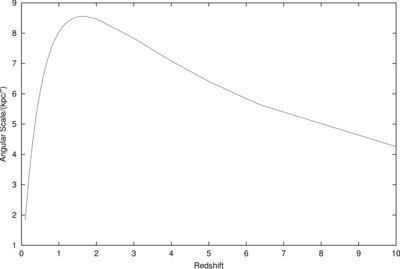 | ||
The angular diameter distance is a distance measure used in astronomy. It is defined in terms of an object's physical size,
The angular diameter distance depends on the assumed cosmology of the universe. The angular diameter distance to an object at redshift,
Where
Where
In the currently favoured geometric model of our Universe, the "angular diameter distance" of an object is a good approximation to the "real distance", i.e. the proper distance when the light left the object. Note that beyond a certain redshift, the angular diameter distance gets smaller with increasing redshift. In other words, an object "behind" another of the same size, beyond a certain redshift (roughly z=1.5), appears larger on the sky, and would therefore have a smaller "angular diameter distance".
Angular size redshift relation
The angular size redshift relation describes the relation between the angular size observed on the sky of an object of given physical size, and the objects redshift from Earth (which is related to its distance,
where
However, in the currently favoured geometric model of our Universe, the relation is more complicated. In this model, objects at redshifts greater than about 1.5 appear larger on the sky with increasing redshift.
This is related to the angular diameter distance, which is the distance an object is calculated to be at from
The actual relation between the angular-diameter distance,
The Mattig relation yields the angular-diameter distance as a function of redshift for a universe with ΩΛ = 0.
